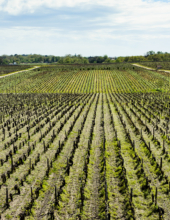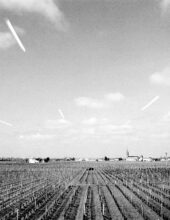25th May 2023
A “breath of fresh air” within a region steeped in history and tradition.

Beware of the Wolf
“One of the risks that Montalcino can run is to become a dinosaur appellation. Most of the producers are commercially very successful, but it is very important not to lose the spirit of research and evolution of our wine culture,” says Sebastian Nasello, the young, energetic winemaker at Podere Le Ripi. “The main issue in Montalcino is that most of the winemakers do not drink enough wine from different places and backgrounds, and this does not help to increase awareness of the aspects to be improved in our wines.” We were talking about the way that some Brunello di Montalcinos have tired aromas of dull oak spice rather than of vibrant Sangiovese, which is partly due, of course, to the enforced long aging in large old oak. And, of course, he is right to say that many winemakers do not often drink wine from other regions and countries, never mind that of their neighbors. This is true not only in Montalcino and not only in Italy but also in many wine regions and countries around the world.

In order to encourage interest in wines from around the world, Sebastian and a few colleagues from Podere Le Ripi have recently opened a wine bar, “Vineria Aperta,” in the small town of Castelnuovo Dell’Abate, near Montalcino. They sell interesting and exciting wines from around the world, as well as listing some of the best Brunellos. To an outsider like me, this is just what the area needs. Happily, more and more Italian winemakers are starting to drink and taste more widely. Even better, some of Italy’s younger wine producers have now spent time making wine in other countries too.
"Brunello has been one of the coolest of Italian wines."
Another activity Sebastian has been involved in with like-minded Brunello producers is organizing a series of tastings throughout Italy’s major cities to encourage younger drinkers to consider choosing a Brunello di Montalcino from the wine list in more informal occasions and settings. Both these actions seem innocuous enough to the outside world, but within Montalcino, they are already seen by some as really rocking the boat! With disarming honesty, Sebastian comments, “Brunello has been one of the coolest of Italian wines, but to keep this appeal in the future, we have to be more focused on new trends in the wine world, on all the changes going on with a new generation of consumers, and also on communication. For example, as the Consorzio del Chianti Classico is doing, spending a lot of time communicating their different terroirs with professional vineyard maps and focusing on the wine more than anything else. Chianti Classico is cool.”


That said, Podere Le Ripi estate has its fair share of coolness and glamour. It is owned by the artistic Francesco Illy of the famous Illy family, a coffee magnate and innovator. The vineyards are cultivated biodynamically and are certified as such, which means there is a holistic attitude to the natural environment. They keep geese, chickens, roosters, cows, and a donkey. Their 34 hectares of vineyards are surrounded by at least three times that area of forest, olive groves, clay canyons, and ponds to encourage as much biodiversity as possible.
They have an amazingly constructed wine cellar that inside winds around like a snail’s shell. It is built using ancient techniques, following “golden ratio” rules, using only “natural clay for the bricks and a mortar made of lime” to “chase harmony” in order to cultivate this in the wine as it spends its first years of life maturing in the cellar. But for me, it is the dedication and passion of Sebastian Nasello at the helm on a day-to-day basis and the strong team he has built around him that really underlines the holistic feeling of the estate.
The style of Podere Le Ripi Brunello tends to be wonderfully silky in texture with brightly expressive, red-fruited Sangiovese qualities.
They make a much more Burgundy-influenced Brunello than the many dark-fruited, powerfully oaked styles or the more historically traditional, understated, sweet tobacco-spiced wines. Their wines are much closer to the style of Brunello produced by Stella di Campalto, Salicutti, and Pian dell’Orino, for example, and they are some of the most intriguing, seductive, and seamlessly textured Brunello di Montalcinos you will find. They have aromas of fresh earth and wildflowers, with a touch of the wild side, and they are very much a snapshot of the countryside that surrounds them.

Situated in the Castelnuovo dell’Abate in the south-eastern corner of the Brunello di Montalcino DOCG, the Podere Le Ripi vineyards benefit from the moderating effects of Monte Amiata which sends cold winds rolling down the mountain at night and acts as a rain shadow for storms. They make three single vineyard Brunellos from their vineyards on two opposite sides of the hill. The west side is a little more isolated and surrounded by dense forest, and the soil is rich in clay and sand, with various rockier, free-draining materials such as galestro and alberese dotted here and there. This produces grapes for their charming and friendly Sogni e Follia (Dreams and Madness) Rosso di Montalcino, and the Cielo D’Ulisse (Sky of Ulysses) Brunello di Montalcino.
The Amore e Magia (Love and Magic) and Lupi e Sirene (Wolves and Mermaids) Brunellos are named after two neighboring vineyards on the eastern side of the hill, which get the early morning sun. The Amore e Magia Brunello reflects a happy combination of sun and Sangiovese on clay soils, creating a wine with what Podere Le Ripi describes as “depth and layers” - but I love it for its sunny personality and charm. The Lupi e Sirene vineyard has an alkaline marl soil with granite deposits. They feel this gives the wine a “blood-like” mineral note due partly to the presence of iron in the soil and a more “earthy and masculine” style. They also make a skin-contact orange-style white wine, which is a blend of Trebbiano and Malvasia called Canna Torta (Twisted Cane).
Their Bonsai Sangiovese, which has a very limited production, typically of 600 bottles, has to be classified as an IGT because the vine density exceeds the legal limits for a Brunello di Montalcino. The Bonsai vineyard is planted at the extremely high density of 62,000 plants per hectare, with the vines only 40 centimeters apart. This, according to Francesco Illy, forces the roots to grow deeper and “grow through many geological layers quickly.”
For the last few years, they have been making an experimental new wine called “Attenti al Lupo” (Beware of the Wolf). The wolf is also a symbol they often use on their labels. This wine is 100% Sangiovese from grapes grown partly on alluvial soils, which allows them to harvest earlier. With this wine, inspired partly by the effects of climate change and partly by the desire to make a lively, energetic Sangiovese to bring out “raw and tastier flavors,” they are experimenting with various fermentation techniques, including the use of stems and semi-carbonic maceration.
Sebastian’s self-searching and self-critical honesty is born of a sincere desire to find what’s best in Brunello Di Montalcino’s DNA and allow it to flourish.
Opening a wine bar and organizing Brunello di Montalcino tastings in Italy’s major cities is all part of this thirst for knowledge and drive for excellence that is like a breath of fresh air. With the impact of climate change still making itself felt on wine styles and winemaking, Sebastian’s earnest quest for discovery in the Brunello di Montalcino DOCG can only be positive. It is exciting to contemplate what effects the Podere Le Ripi influence may have in the future. “Attenti al Lupo” - beware of the wolf - becomes a very fitting motto for them.
–
Article & Reviews by Susan Hulme MW
Photography by Svante Örnberg
See more work from Svante at svanteornberg.se by clicking here!

PRODUCERS IN THIS ARTICLE
> Show all wines sorted by scoreMore articles

Bordeaux 2023 Vintage Report and Reviews from Barrel
09th May 2024
649 tasting notes

Cathiard Vineyard New Releases
02nd May 2024
3 tasting notes

Bordeaux 2023 Preliminary Vintage Report and Reviews from Barrel
29th Apr 2024
56 tasting notes

2021 Bordeaux in Bottle and A Modest Proposal
24th Apr 2024
599 tasting notes
Show all articles